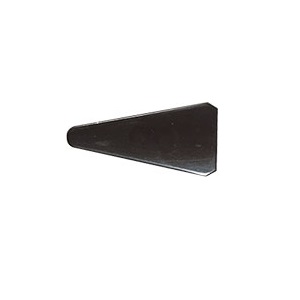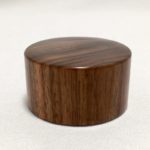Q: Why do you recommend a contrabassoon plaque over a standard bassoon plaque?
 A: The contrabassoon plaque has a bigger (flatter) radius on the surface of the plaque. When nibbling across the tip, the knife is in contact with more cane than the smaller, more-rounded radius of most bassoon plaques. Because the knife grabs more cane and encounters more resistance, there is less of a tendency to take out deep chunks. It is important to know that the knife should be sharpened with a scraping burr which “lifts” the cane rather than slicing deeply through the cane at the tip. Another benefit of the contrabassoon plaque is its size. You are less likely to lose it!
A: The contrabassoon plaque has a bigger (flatter) radius on the surface of the plaque. When nibbling across the tip, the knife is in contact with more cane than the smaller, more-rounded radius of most bassoon plaques. Because the knife grabs more cane and encounters more resistance, there is less of a tendency to take out deep chunks. It is important to know that the knife should be sharpened with a scraping burr which “lifts” the cane rather than slicing deeply through the cane at the tip. Another benefit of the contrabassoon plaque is its size. You are less likely to lose it!
The best metal plaque is a very thin, slightly contoured type. The best plaque, however, is an ebony plaque. (See next question.)
Many bassoonists have had bad luck using a knife to thin and taper the tip and resort to files or sand paper. The use of a properly sharpened knife, proper knife style (hollow ground), and careful technique (1-2-3-4-push) can eliminate taking chunks out of the tip.
Q: Why do you not list an inexpensive plastic plaque but list an ebony plaque?
 A: The plastic plaque again has a smaller radius as mentioned above and is too thick, spreading the blades apart, which can lead to cracking the blade, especially when the reed is not soaked up enough. The second reason to NOT use a thick, plastic plaque is that it widely separates the blades, and when returning to playing and testing the reed, it takes some time for the reed to settle back into its proper playing mode and tip opening.
A: The plastic plaque again has a smaller radius as mentioned above and is too thick, spreading the blades apart, which can lead to cracking the blade, especially when the reed is not soaked up enough. The second reason to NOT use a thick, plastic plaque is that it widely separates the blades, and when returning to playing and testing the reed, it takes some time for the reed to settle back into its proper playing mode and tip opening.
 The ebony plaque is superior to the contrabassoon plaque for three reasons: 1) it is nearly flat and will not widely separate the blades, 2) it has a very gentle curve which allows safe “nibbling” at the tip, and 3) like a plastic plaque, it will not dull the scraping burr on the tip of the knife as is the case with a metal plaque.
The ebony plaque is superior to the contrabassoon plaque for three reasons: 1) it is nearly flat and will not widely separate the blades, 2) it has a very gentle curve which allows safe “nibbling” at the tip, and 3) like a plastic plaque, it will not dull the scraping burr on the tip of the knife as is the case with a metal plaque.
Q: If I’m using a drill bit for a reamer, where do I buy a handle for it?
A: Try to find a drill bit that has a 1/4-inch shank which can fit into some tool handles found at hardware stores.
Q: How do I shorten a tapered rat-tail file or drill bit?
A: If you have access to a bench grinder, the excess length of rat-tail file or drill bit can be ground away. The amount to remove from the recommended rat-tail file is approx. 1-1/8 inches from the tip. Wrap tape around the circumference of the file at 1-1/8″ to mark the point of the cut. Rotate the piece against the corner of the rotating grinder blade. Either stop at the point where you have made a groove around the circumference or continue rotating until it grinds through. By stopping part way through you can clamp the end to be removed in a vice and snap it off.
Follow the same procedure for the drill bit. The amount to remove from the drill bit is approximately 1/2-inch from the tip.
The excess in the back of the file can also be removed quickly by clamping it in a vice and breaking it off with a blow from a hammer. (This is a little tricky to do! This technique can also be done with the tip, but not recommended.)
Q: How do I cut the tip using a razor blade and guitar pick?
A: Do this with a thoroughly wetted reed. Place the guitar pick next to the edge of a table or counter. Squeeze the reed blades shut and place it firmly onto the guitar pick. Place the razor blade against the flattened blade, at a 90 degree angle at the point you’ve marked in pencil to cut away. Press the razor blade straight down into the guitar pick with sufficient pressure to cut through both blades.
Q: Why do you not recommend using a cutting block (billot)?
 A: Most cutting blocks have a rounded surface where you will cut the blade. It is very easy when using a razor blade or a knife to end up with a cut that is not straight or is not cut all the way through. There are two sizes of cutting blocks: oboe size and bassoon size. If a cutting block is your preferred method, flatten the surface by sanding until you have a flat cutting platform. It is easier to cut down straight through the reed using both hands pressing down on the knife or razor blade than rocking the blade across a curved surface. If the budget allows, purchase a tip cutting tool. There are several varieties of reed tip clippers available at double reed specialty shops. A flat blade garden pruner or sewing/craft scissors can be a viable option.
A: Most cutting blocks have a rounded surface where you will cut the blade. It is very easy when using a razor blade or a knife to end up with a cut that is not straight or is not cut all the way through. There are two sizes of cutting blocks: oboe size and bassoon size. If a cutting block is your preferred method, flatten the surface by sanding until you have a flat cutting platform. It is easier to cut down straight through the reed using both hands pressing down on the knife or razor blade than rocking the blade across a curved surface. If the budget allows, purchase a tip cutting tool. There are several varieties of reed tip clippers available at double reed specialty shops. A flat blade garden pruner or sewing/craft scissors can be a viable option.
